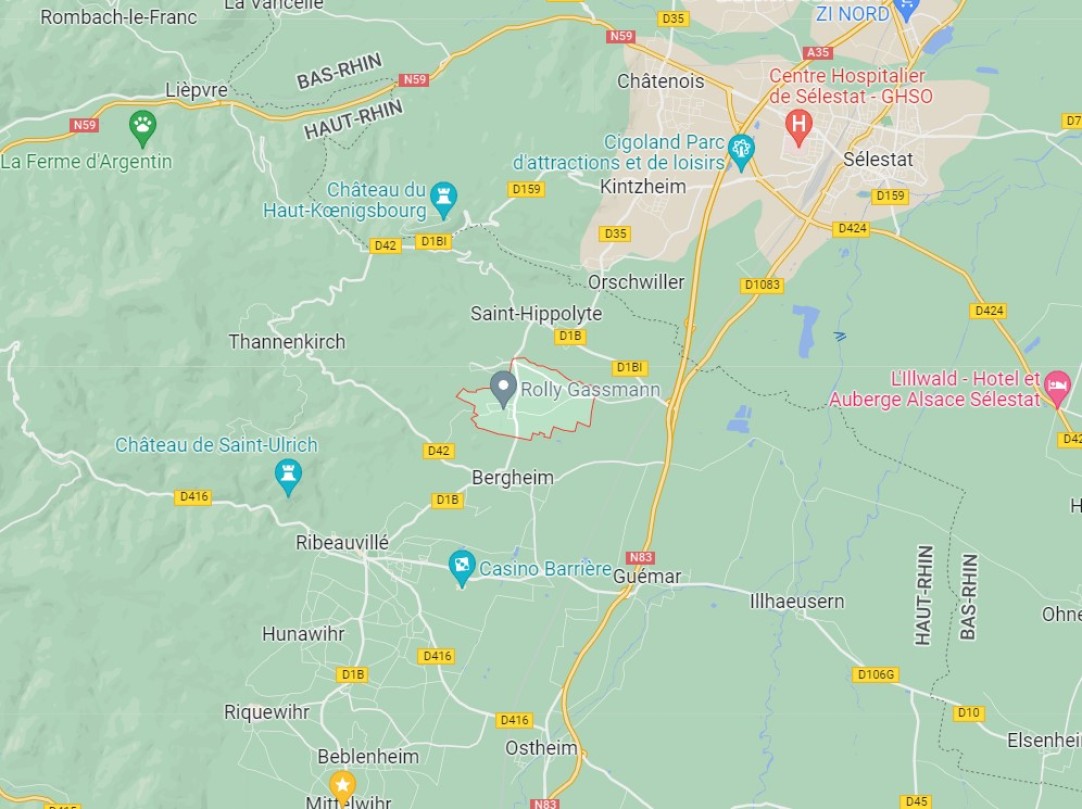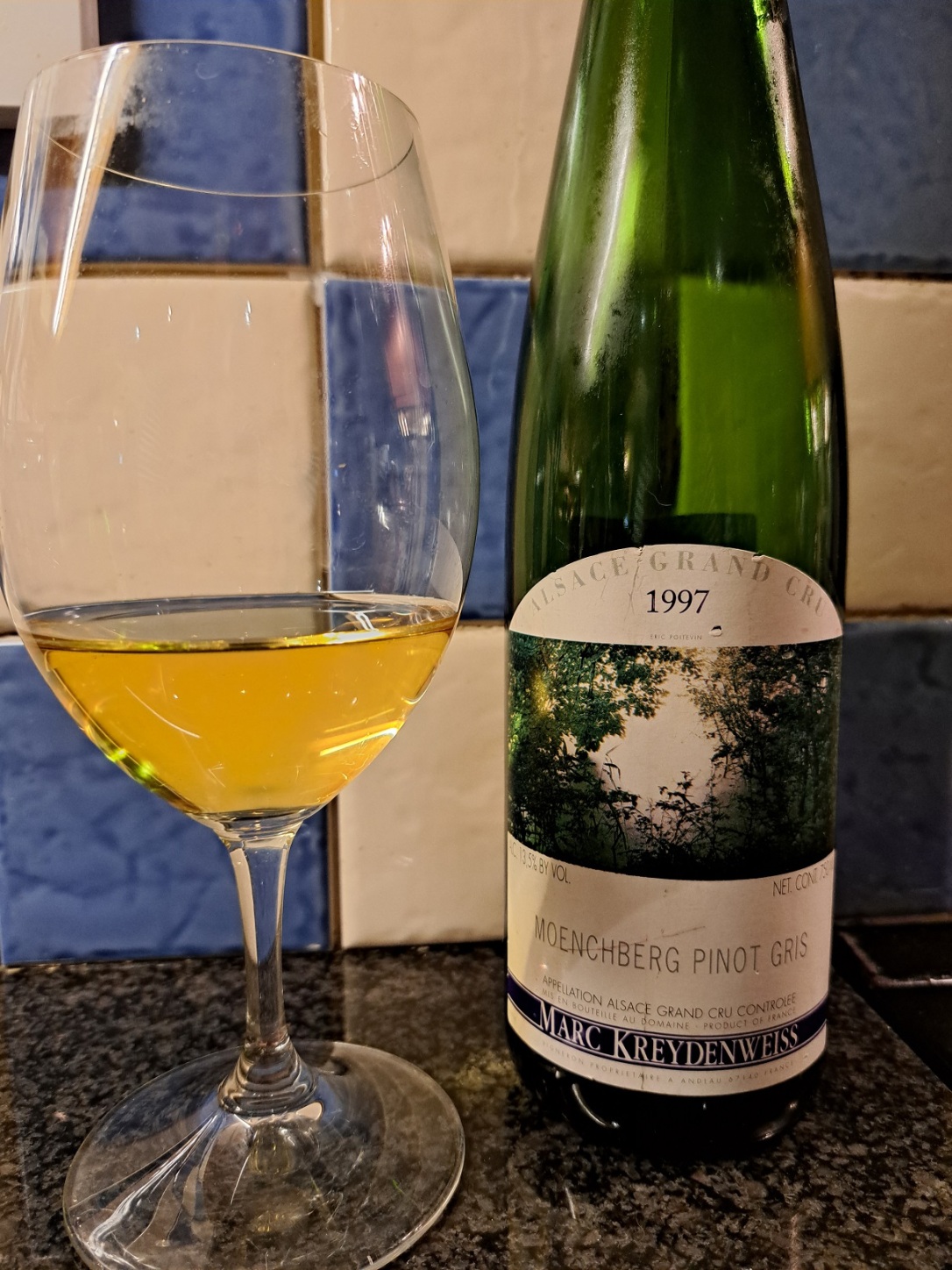Rolly Gassmann is an excellent producer of Alsace wines, based in the village of Rorschwihr. To give the wines the context they deserve, first we will look at Rorschwihr itself, then the background to Rolly Gassmann and their wine philosophies, before exploring some of the wines available here in Ireland.
Rorschwihr

Rolly Gassmann in Rorschwihr, Alsace
Rorschwihr is at the top of the Haut-Rhin department close to the border with the Bas-Rhin. Unsurpringingly given its location, it has a long history of winemaking and has been associated with lots of important historical figures. The Merovingians, Carolingians and Hapsburgs have had their stints as vineyard owners here. A long list of religious orders and Popes have also owned land in the village. Unusually for Alsatian wine villages, each major wine family owned and operated their own press rather than relying on a communal one.
Even within Alsace which is famed for the diversity of its soils, Rorschwihr’s terroirs are particularly complex. It lies on the Ribeauvillé fault line which runs north-south, inbetween the Vosges and Rhine fault lines, and so has over 20 identifiably different soil types. When the Alsatian wine authorities were looking to establish Grand Crus in the area, they sought to combine several areas which were already recognised as distinct by the locals, who decided that either 12 climats were worthy of Grand Cru status or none at all. Those climats are today among the named lieux-dits of Rorschwihr and are candidates for future Alsace 1er Cru status.
Rolly Gassmann
The list of double-barrelled surnames on this website will continue to grow – Kuentz-Bas was the first with Sipp Mack and Meyer-Fonné in the pipeline. Both the Rolly and Gassmann families had centuries of winemaking behind them when a branch of each were joined through marriage in 1967. Pierre Gassmann is the current proprietor and is the son of the founding pair.
The domaine has a total of 52 hectares under vine, 40 of which are in Rorschwihr and 10 a few clicks to the south in Bergheim. Rolly Gassmann has holdings in many of the lieux-dits referred to above:
| Altenberg de Bergheim |
Kappelweg de Rorschwihr |
Oberer Weingarten de Rorschwihr |
Silberberg de Rorschwihr |
| Brandhurst de Bergheim |
Kugelberg de Rorschwihr |
Pflaenzerreben de Rorschwihr |
Stegreben de Rorschwihr |
| Haguenau de Bergheim |
Lachreben de Rorschwihr |
Rotleibel de Rorschwihr |
Steinkesselreben de Rorschwihr |
| Grasberg de Rorschwihr |
Moenchreben de Rorschwihr |
Pflaenzerreben de Rorschwihr |
Weingarten de Rorschwihr |
Each of the lieux-dits has different terroir and so is best suited to different varieties. Here are further details of three of them whose wines make it to Ireland:
Keppelweg de Rorschwihr (Way of the Chapel) covers 5.67 hectares at 225 to 235 masl (it is part of a plateau). Its soils are a mixture of clay, marl and loam with lots of stones, dating back to 1.6m – 2.0m years ago. The aspect is south and south-east. Riesling and Gewurztraminer fare best here.
Brandhurst de Bergheim (Burning Bush) has heavy marl soils arranged in a semi circle between 250 and 300 masl with a south and south-east aspect. It is in a well-sheltered location and never lacks for water. The soils are fairly fertile and retain heat which makes them good for noble rot. The varieties planted are 60% Gewurztraminer, 15% each of Pinot Gris and Riesling and the remaining 10% made up of Muscat, Auxerrois, Pinot Noir and Sylvaner.
Oberer Weingarten de Rorschwihr (Upper Wine Garden) has clay and silt soils with siliceous pebbles and limestones, all dating back to 0.8m years ago. Its 6 hectares are mainly planted to Gewurztraminer and Riesling at 225 to 260 masl.
RG wines which do not state a lieu-dit are either from outside those delimited vineyards or are made from grapes harvested from several lieux-dits blended together.
Rolly Gassmann Wine Styles and Philosophy
Pierre Gassmann has taken the wines down the organic and biodynamic paths, but the domain is certified for neither; these approaches to viticulture are followed for their own good rather than as a selling point on a label. Rolly Gassmann also follows sustainable principles and its wines are vegan-friendly.
In the vineyard, harvest takes place when the wines are fully ripe, even with some botrytis, so that sugar levels are high and flavours are concentrated. Integrating them takes time, and the wines are aged in Rolly Gassmann’s spectacular new winery until they are ready to drink. Known locally as La Cathédrale, the facility has six floors built into the hillside and uses gravity to move grapes, must and wines from one stage of the process to the next. It also has considerable storage, with up to a million and a half bottles laid down, equating to five years’ production.
The finished wines generally have more residual sugar than is the norm in Alsace, but they can cellar for much longer, even given the extra pre-release ageing. Additional ageing lessens the apparent sweetness of wines over time, though my understanding is that this is due to the evolution of flavours rather than any change in actual sugar content.
Now we move onto notes from some of the wines available in Ireland:
Domaine Rolly Gassmann Sylvaner Réserve Millésime 2017

According to Monty Python, nobody expects the Spanish Inquisition, but neither do they expect sweentness in Sylvaner. Long relegated to an also-ran, this grape variety can really shine given a chance. Its deep lemon colour gives a heads up on the palate sweetness. The nose is full of luxurious ripe peach, apricot, nectarine and three fruits marmalade. On the attack, it initially tastes quite dry, mineral and tangy – what you might expect from a typical Sylvaner. In the mid palate the baton is passed back to the rich stone fruits which usher it to the finish.
This is not a typical Sylvaner, but it’s all the better for its unique, glorious style.
- ABV: 12.0%
- RS: 29 g/L
- RRP: €25.99
- Stockists: Baggot Street Wines; Blackrock Cellar; Michaels at Higgins Butchers Sutton; Redmonds of Ranelagh; wineonline.ie
- Source: sample
Domaine Rolly Gassmann Riesling 2019

The grapes for this “entry level” Riesling are gently pressed for eight to twelve hours then fermented for four to five months with indigenous yeasts. Maturation is on fine lees for another six or seven months before bottling. It has a touch of colour in the glass, unusual for a grape which often produces water-clear wines. The nose has citrus fruits and white flower blossom, perhaps a touch of honey. The palate is perfectly balanced, with fine acidity matched to a small amount of sweetness. There’s a light smokiness which actually reminded me of some old vine Sylvaners that I have tried. This is a complex wine for such a relative youngster.
- ABV: 13.5%
- RS: 13 g/L
- RRP: €28.99
- Stockists: Avoca Handweavers Shops; Baggot Street Wines; Blackrock Cellar; Michaels at Higgins Butchers Sutton; Redmonds of Ranelagh; The Malt House; wineonline.ie
- Source: purchased from Baggot Street Wines
Domaine Rolly Gassmann Kappelweg de Rorschwihr Riesling 2014

For those not that familiar with Alsace it might seem strange that an upmarket Riesling (this one) might have more residual sugar the the standard Riesling (above), but it all makes sense in context. Firstly, the better sites get more sunshine so there are likely to be higher sugar levels at harvest time. With longer time in the press and longer fermentation time, this lieu-dit Riesling has more texture and body, so the residual sugar complements that perfectly. Also, the much longer time before release allows all the components to integrate in a melifluous manner.
Rolly Gassmann own 5.67 hectares of the lieu-dit Kappelweg de Rorschwihr from which they currently have three wines available (in France); this 2014 Riesling, a 2019 Gewurztraminer (not the wine below) and a Vendanges Tardives Riesling from 2005! This Riesling is superb, a fine mosaic of different citrus fruits, floral notes and ripe stone fruits. Rorschwihr might not have any Grand Cru classified vineyards but this is certainly of Grand Cru quality.
- ABV: 13.0%.
- RS: 26 g/L
- RRP: €45.99
- Stockists: Baggot Street Wines; Blackrock Cellar; Michaels at Higgins Butchers Sutton; Redmonds of Ranelagh; wineonline.ie
- Source: sample
Domaine Rolly Gassmann Brandhurst de Bergheim Pinot Gris 2013

The Full Monty. The Whole Shebang. The Whole Nine Yards. Pear Cider That’s Made From 100% Pears. There are many colloquial phrases which imply that something is an archetype, the best of its kind. To that I would like to add Domaine Rolly Gassmann Brandhurst de Bergheim Pinot Gris…do you think it will catch on?
In the glass it’s a light gold, a combination of sweetness and age adding to the depth of colour. The nose has exhuberant notes of red apple, conference pears, poached apricots and even toffee. It’s just delightful in the mouth, with Pinot Gris’s textured dry notes surrounded by sumptuous fruit.
This wine shows why Pinot Gris is (narrowly) my second favourite variety in Alsace. Pinot Gris done right!
- ABV: 14.0%
- RS: 42 g/L
- RRP: €41.99
- Stockists: Baggot Street Wines; Blackrock Cellar; Michaels at Higgins Butchers Sutton; Redmonds of Ranelagh; wineonline.ie
- Source: sample
Domaine Rolly Gassmann Gewurztraminer 2016

As I state frequently in my prose, Gewurztraminer is a tricky grape to get right, even in its spiritual home of Alsace. This is the Goldilocks of Gewurz, not too dry, not too sweet, just perfectly poised and balanced. It’s an expressive wine, but not one that gets carried away with itself. The unmistakeable Gewurz nose is exotic without being redolent of fake perfumes from a market stall. The palate has delicious stone and pip fruits – apricot, quince and peach – with ginger and other spices. Rolly Gassmann has made Goldilocks’ perfect wine: graceful, balanced, not trying too hard nor trying to be anything else.
- ABV: 13.5%
- RS: 30 g/L
- RRP: €35.99
- Stockists: Baggot Street Wines; Blackrock Cellar; Michaels at Higgins Butchers Sutton; Redmonds of Ranelagh; wineonline.ie
- Source: purchased from Baggot Street Wines
Other Domaine Rolly Gassmann Wines available in Ireland
In addition to the five “regular” wines reviewed above there are two further Rolly-Gassmann wines available in Ireland, both sweet styles:
- Riesling de Rorschwihr `Cuvée Yves` Vendanges Tardives 2010: RRP €59.99, Stockists: Barnhill Stores, Dalkey; The Corkscrew; Jus De Vine, Portmarnock
- Oberer Weingarten de Rorschwihr Gewürztraminer Vendanges Tardives: RRP €67.99, currently no retail stockists, but available in some restaurants









